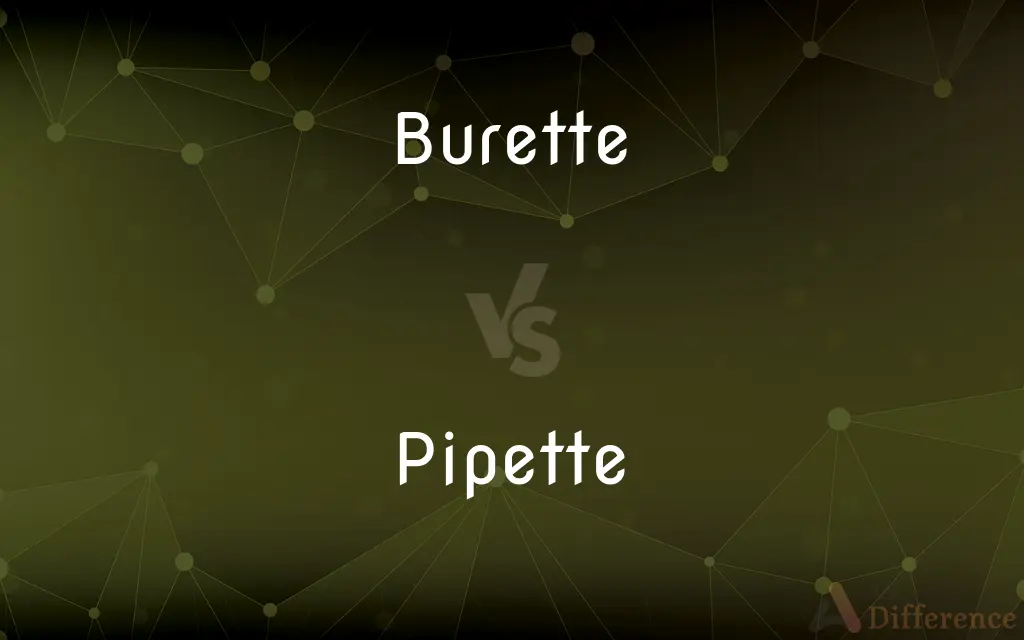Burette vs. Pipette — What's the Difference?
Edited by Tayyaba Rehman — By Fiza Rafique — Updated on September 25, 2023
A burette is a laboratory glassware used for precise measurement and delivery of liquids, often in titration experiments. A pipette is a laboratory tool designed for accurate measurement and transfer of specific volumes of liquids.

Difference Between Burette and Pipette
Table of Contents
ADVERTISEMENT
Key Differences
Burettes are primarily used in analytical chemistry to deliver precise amounts of a liquid reagent. Pipettes are used in various scientific fields for tasks like sample preparation, measuring volumes, and transferring liquids.
Burettes are long, graduated glass tubes with a stopcock or valve at the bottom to control the flow of liquid. Pipettes come in various designs, including volumetric and graduated, with a tapered tip for precise liquid withdrawal.
Burettes are essential for titration techniques, where the volume of a solution is precisely measured to determine the concentration of another substance. Pipettes find use in diverse applications, such as biology, chemistry, and medical laboratories, for tasks like aliquoting samples and dilutions.
Comparison Chart
Meaning
Glassware for precise liquid delivery
Tool for accurate liquid measurement
Usage
In titration experiments and chemical analysis
In various scientific fields for liquid handling
ADVERTISEMENT
Design
Graduated glass tube with stopcock
Various designs, tapered tip
Applications
Primarily for titration techniques
Widely used in labs for multiple tasks
Typical Volume Range
Larger volumes (mL)
Covers a broad range (µL to mL)
Compare with Definitions
Burette
A laboratory glassware for precise liquid delivery, often used in titration.
The chemist carefully added the titrant from the burette to the reaction mixture.
Pipette
A lab equipment used to aliquot specific volumes of liquids.
The medical technician used a pipette to dispense exact amounts of serum for testing.
Burette
A tool for controlled addition of liquids in analytical chemistry.
The titration required the use of a burette to determine the concentration of the unknown solution.
Pipette
A tapered instrument designed for accurate liquid withdrawal.
The chemist relied on a micropipette for precise measurement of reagents.
Burette
A graduated tube with a stopcock, used for accurate liquid measurement.
The scientist used the burette to dispense exactly 25 mL of the solution.
Pipette
Laboratory tool for precise liquid measurement and transfer.
The microbiologist used a pipette to transfer a small volume of the bacterial culture.
Burette
A device for measuring and dispensing liquids with high accuracy.
The student carefully read the burette scale to record the volume accurately.
Pipette
A versatile tool for liquid handling in scientific research.
The researcher employed a pipette for various experiments, from PCR to cell culture.
Burette
A glass instrument used to deliver precise volumes of liquid.
The laboratory technician calibrated the burette before the experiment.
Pipette
An essential instrument for achieving precision in liquid handling.
The analytical chemist trusted the pipette for accurate sample dilutions.
Burette
A burette is a graduated glass tube with a tap at one end, for delivering known volumes of a liquid, especially in titrations. It is a long, graduated glass tube, with a stopcock at its lower end and a tapered capillary tube at the stopcock's outlet.
Pipette
A pipette (sometimes spelled pipet) is a laboratory tool commonly used in chemistry, biology and medicine to transport a measured volume of liquid, often as a media dispenser. Pipettes come in several designs for various purposes with differing levels of accuracy and precision, from single piece glass pipettes to more complex adjustable or electronic pipettes.
Burette
A glass tube with fine, volumetric graduations and a stopcock at the bottom, used especially in laboratory procedures for accurate fluid dispensing and measurement.
Pipette
A narrow, usually calibrated tube into which small amounts of liquid are suctioned for transfer or measurement.
Burette
(chemistry) A glass tube with fine gradations and a stopcock at the bottom, used in laboratory procedures for accurate fluid dispensing and titration.
Pipette
(sciences) A small tube, often with an enlargement or bulb in the middle, and usually graduated, used for transferring or delivering measured quantities of a liquid.
Burette
(religion) An altar cruet.
Pipette
To transfer or measure the volume of a liquid using a pipette.
Burette
An apparatus for delivering measured quantities of liquid or for measuring the quantity of liquid or gas received or discharged. It consists essentially of a graduated glass tube, usually furnished with a small aperture and stopcock.
Pipette
A small glass tube, often with an enlargement or bulb in the middle, and usually graduated, - used for transferring or delivering measured quantities.
Burette
Measuring instrument consisting of a graduated glass tube with a tap at the bottom; used for titration
Pipette
Measuring instrument consisting of a graduated glass tube used to measure or transfer precise volumes of a liquid by drawing the liquid up into the tube
Common Curiosities
Can a pipette be used for titration?
Yes, pipettes can be used for titration if they provide the required precision and accuracy.
How does a burette differ from a graduated cylinder?
A burette has a stopcock for precise liquid delivery, while a graduated cylinder is used for approximate volume measurements.
What is a burette used for?
A burette is used for precise liquid delivery, often in titration experiments and chemical analysis.
Are burettes and pipettes made of the same material?
Both burettes and pipettes are typically made of glass, although plastic versions are also available.
What is the purpose of the stopcock on a burette?
The stopcock on a burette controls the flow of liquid, allowing for precise and controlled delivery.
What is the difference between a volumetric pipette and a graduated pipette?
A volumetric pipette delivers a specific volume accurately, while a graduated pipette can measure and deliver variable volumes with less precision.
How are pipettes calibrated for accuracy?
Pipettes are calibrated using standard solutions and adjustment techniques to ensure accurate measurements.
What is the smallest volume a micropipette can handle?
Micropipettes are capable of handling volumes in the microliter (µL) range, with some models measuring down to nanoliters (nL).
Can a burette measure microliters (µL)?
Burettes are typically used for larger volumes in milliliters (mL) and are not suitable for microliter measurements.
What are some common applications of pipettes?
Pipettes are used in various scientific fields for tasks like measuring volumes, transferring liquids, and sample preparation.
What is the typical tolerance or error associated with burettes and pipettes?
The tolerance or error of burettes and pipettes varies depending on their calibration, but they are designed for high accuracy, often with errors less than 1%.
What precautions should be taken when using a burette or pipette?
Users should ensure cleanliness, proper calibration, and correct technique to achieve accurate results.
Are pipettes disposable or reusable?
Pipettes can be both disposable and reusable, depending on the type and laboratory's requirements.
Can a single burette be used for various types of liquids?
Burettes can be used for different liquids, but they should be thoroughly cleaned and rinsed between uses to avoid contamination.
What is the importance of using precise measuring instruments like burettes and pipettes in laboratories?
Precise measuring instruments like burettes and pipettes are essential for obtaining accurate and reproducible results in scientific experiments and analyses.
Share Your Discovery

Previous Comparison
Obtain vs. Get
Next Comparison
Diagnosis vs. TreatmentAuthor Spotlight
Written by
Fiza RafiqueFiza Rafique is a skilled content writer at AskDifference.com, where she meticulously refines and enhances written pieces. Drawing from her vast editorial expertise, Fiza ensures clarity, accuracy, and precision in every article. Passionate about language, she continually seeks to elevate the quality of content for readers worldwide.
Edited by
Tayyaba RehmanTayyaba Rehman is a distinguished writer, currently serving as a primary contributor to askdifference.com. As a researcher in semantics and etymology, Tayyaba's passion for the complexity of languages and their distinctions has found a perfect home on the platform. Tayyaba delves into the intricacies of language, distinguishing between commonly confused words and phrases, thereby providing clarity for readers worldwide.
















































